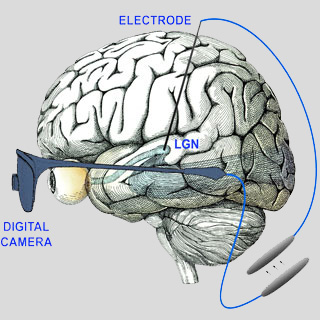|
|
John Pezaris' Electrode Implant
The neurostimulator implant envisaged by researcher John Pezaris, is not the same as the medical neurostimulators currently in use. It is one of the first true neurostimulators. That is to say, not a general pulse device, but one capable of delivering meaningful data directly into the brain. It is also the embodiment of the 'virtual sight' device. It gives sight to the sightless.
John Pezaris, is an assistant in neuroscience at Massachusetts General Hospital in Boston, and he has been garnering interest in his work for a number of years now. Its no pie in the sky idea either. The implant is still early stages, but every aspect of it builds on existing technology. It is a mix of BrainGate technology, augmented reality, wearable computing and body area networking. On the outside, a pair of spectacles would be worn by the patient. These spectacles don't have lenses, at least in the traditional sense. Instead that space is taken up with electronics. Since it is possible to build transparent electronics they need not look any different from normal glasses, or alternatively the production models could look like something produced by Vuzix. It does not really matter, at this stage. All that matters is that the glasses contain a pair of cameras, each recording the visual feed for one side of the face, in place of the non-functional eye or eyes behind them. The rest of that side of the spectacles contain the processing power to reduce that image to its key elements, same as the retina of the eye, and beginning of the optic nerve does. These AR glasses then run a wire at the end of each of the arms, to a point at the top of the user's head where a small wi-fi array disk is. There they rest, held in place by hair pins or scalp glue. The disk, communicates with its opposite number under the skull, sending data back and forth across unbroken skin. This is important, as if the skin is allowed to heal after implantation of the prosthetic, it prevents infection into the site - something the BrainGate project has taught us, is a big problem. Not least because there is no immune system active in the brain itself. Under the skull, the other end of the wi-fi system is just a receiver. It has no need to transmit any data, so it just accepts the data of its counterpart. From there a small bundle of very thin wires run down, through the brain itself, to the LGN - the lateral geniculate nucleus, a small area of the brain on the lower side of the frontal lobes, where the optic nerve meets the brain, and visual processing really begins in earnest. This is where the prosthetic itself sits, the electrode array bonded directly with the neurons of the LGN, basically serving as an artificial optic nerve. Even if the significant technological challenges can be overcome, the visual signal output is not going to be anywhere near the same fidelity of a natural eye, at least at first, and for some time after that. However, if it provides enough functional sight to tell light from dark, then it's a success, and Pezaris is hoping for much more than that. The ability to tell shapes, recognise human faces, begin to interact with the world visually again. That is his plan. In order to achive that, a significant amount of the neural codes in the optic nerve have to be reverse engineered. Some already have been, giving a basic capability for sight. Even if we understood all of them, there is stil lthe matter of determining which neuron clusters in the LGN the signals get sent to, and connecting a prosthetic to them without doing undue damage to the brain tissue above them. To aid the latter issue, Pezaris has enlisted the help of Emad Eskandar, a neurosurgeon also at Massachusetts General Hospital who specializes in deep-brain stimulation, which has been used to treat Parkinson's disease and monitor neural activity in people suffering from seizures. The best way to test the effectiveness of Pezaris's prosthesis is to implant the electrodes in a human patient, a step that requires funding, approval from MGH's institutional review board and a volunteer whose condition is amenable to the treatment. Pezaris, who joined the hospital in November from Harvard Medical School's Department of Neurobiology, says he is in the process of trying to meet all of these criteria but does not know when a human trial might happen. Pezaris is hoping to have a functioning device ready for human testing within a few years, noting that his approach allows him to leverage a lot of existing medical technology. Yet he's careful when describing his project's prognosis: "since it's so early on in the process, and we don't want to overpromise or take unnecessary risks." ReferencesLocalNovel:
Virtual Light Book Quotes: Sight Without Eyes ExternalDeep brain implants show bionic vision promise (PDF) "Bionic" eye restores vision after three decades of darkness Scientists Set Sights on an Implantable Prosthetic for the Blind The Lateral Geniculate Nucleus The Structure of the Visual System Staff Comments
|
|
||||||||||||||||||||||||||||||||||||
|
||||||||||||||||||||||||||||||||||||||

